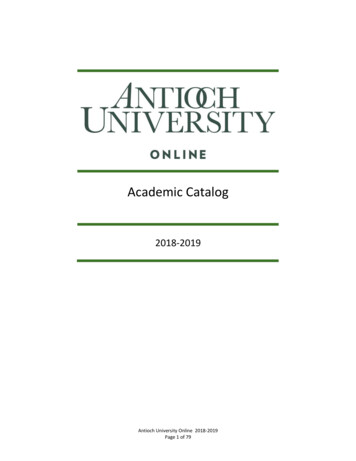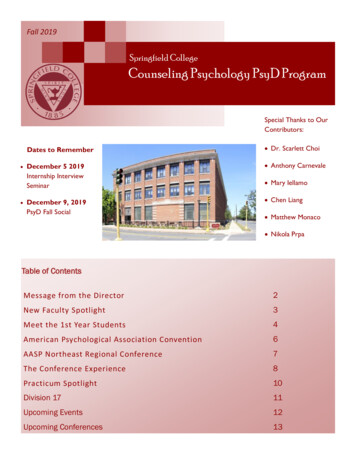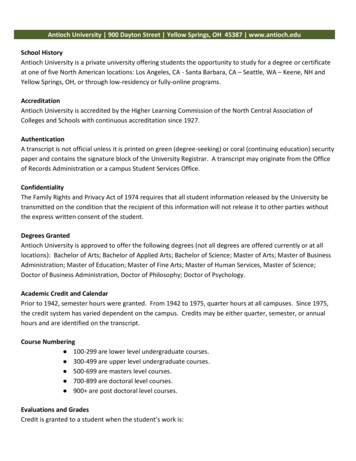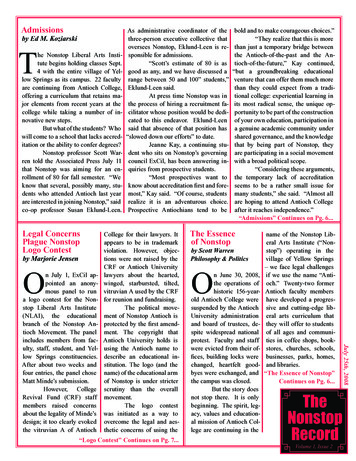
Transcription
Antioch UniversityNew EnglandPsyD Dissertation Handbook(revised December 2019)
Table of ContentsOverview4Nature of the Problem4The Sequence of Dissertation Work6The Doctoral Dissertation Committee7Processes and Tasks toward Completing the Dissertation9Format of the Dissertation Proposal11The Dissertation Draft13The Dissertation Defense/Final Orals15Depositing the DissertationStructure of the Dissertation1818Dissertation FormatPaginationThe AbstractPublicationMarginsSpacingSize and Quality of TypefaceIllustrative MaterialTable of ContentsLists of Tables and FiguresHeadingsTables and FiguresAppendicesOrder of Parts of the ion Support after the Fourth Year26Statute of Limitations27Procedures for the Changing of a Dissertation Chairperson28Important Dates and Timelines29Formatting Dissertations in Microsoft Word542
Appendix A: Example of a Dissertation Title Page63Appendix B: Example of a Dissertation Table of Contents64Appendix D: APA Style Checklist for Dissertation Manuscripts66Appendix E: Dissertation Format Editing Process683
OverviewThe PsyD degree at Antioch New England is awarded only after the completion of the DoctoralDissertation. The PsyD Dissertation is viewed as an essential ingredient in the development of apractitioner with the knowledge and skills of a scholar, capable of bringing scientific andcontextually rich inquiry into the various realms of professional psychology. In the context ofour Core Value of Evidence Based Practice, purposive disciplined inquiry and formal researchfor the PsyD are seen as integral to, rather than distinct from, professional practice.The Dissertation process challenges students to integrate psychological theory and research,consonant with their professional mission, with a repertoire of scholarly and scientificmethodologies in order to develop answers to a set of problems. We encourage students to tapinto a broad range of research methods in their consideration of the Dissertation design. Inaddition, the PsyD Dissertation should address and seek to inform an identifiable audiencebeyond the Dissertation Committee, and represent a contribution to identifiable domains ofprofessional psychological practice and/or scholarship.The quality of the PsyD Dissertation is evaluated based on the following criteria:(a) the student’s formulation of a question relevant to professional psychology;(b) attention to the historic and social context of the project; (c) the use of existing psychologicaland social science methods of disciplined inquiry to address that question, including a criticalunderstanding of the method’s relative strengths and limitations; (d) the scholarly treatment ofthe relevant psychological literature and empirical or discursive materials; (e) systematic analysisof findings; (f) coherent written expression; and (g) the project’s pedagogical implications for thestudent’s personal and professional skill development as a clinical psychologist.Nature of the ProblemThe Dissertation draws on one’s capacities for planning, organizing, and task execution. Ideasmust be located within a context, and contained within a structure that both focuses and delimitstheir scope. For the doctoral student, this context consists of the psychological and relevantsocial science literature as archived in major libraries; the current evidence-based practices andtheoretical frameworks of the profession; socio/cultural/political context, professional andpersonal ethics, and the particular knowledge, interests, and theoretical predilections of thestudent’s doctoral committee (see below).The PsyD Dissertation should adhere to APA guidelines for scholarly writing: focused, cogentscholarship, and conceptual depth, in order that it may find a receptive audience within the rangeof contexts available to professional psychologists (for example, professional publications,specific agencies or institutions, funding sources, professional presentations and training,consultations, and other psychological forums). The student must carefully attend to theexigencies of time, clarity of the project’s conceptualization, availability of resources, personalstrength and weakness, methodology, and institutional and faculty cooperation in designing aproject.Some examples of projects a student might pursue follow:4
Empirical StudyThis involves the collection, analysis, and interpretation of original data (broadly defined toinclude secondary analysis of archival data already available, replications, content analysis,media, etc.) to address a problem of theoretical or practical interest.Theoretical PaperA thorough review of the literature pertaining to a problem, which integrates two or moretheoretical positions, or which places an array of research findings under a new theoreticalumbrella. This work should be rigorous, integrative, critical, and parsimonious. It shouldcommunicate a clear viewpoint developed by the student in the course of the research. Inaddition, the practical and empirical implications of the analysis should be delineated.Program EvaluationAn empirical study explicitly intended to support the design, delivery or impact of a humanservice program. May include questions pertaining to program utilization, implementation, finetuning, and effectiveness. The use of traditional empirical, as well as action research methods issupported.Integrative Case StudyA clinical case (or cases) is used to test, substantiate, or clarify a specific theoretical propositionthat exists in the professional psychology literature. The Case Study overlaps with theTheoretical Paper in its integration or contrasting of two or more theoretical positions withrespect to a phenomenon; and in the requirement that it be thorough, critical, and rigorouslypresented. It differs in the extent to which clinical case material is used to illustrate particularpoints. Case studies are particularly appropriate when instances of a phenomenon are rare, whena phenomenon is best illustrated as exemplary cases rather than in descriptions of populationsattributes; when the investigation involves mobilization of resources that would prohibit moretraditional analyses, when replications within or between a small number of cases are possibleand particularly illuminating, and/or when the phenomenon is so complex as to demandextensive localized observation and description.Design of an Innovative ProgramThis includes a theoretical and practical justification for the program, goals and objectives, plansfor program implementation, and a workable plan for program evaluation. Kinds of programsstudied can include treatment interventions, prevention programs, organization consultations, etc.The Relationship Between Psychology and Public PolicyThere are many areas of public policy where psychology might have an impact, either by directservice or though consultation based on existing psychological knowledge and practice (e.g.,nuclear arms; environmental policy, policies affecting children, mentally ill, elderly, etc.).Dissertations of this type involve a thorough analysis of the history and rationale for a currentpolicy; a rigorous and critical integration of relevant psychological knowledge; and specificrecommendations for policy modification, research, and/or service that might be provided byprofessional psychologists.5
The above suggestions are intended only as examples. Other formats or combinations of thesemay be desirable depending on the question the student chooses to pursue, and negotiates withthe dissertation committee. The main requirements are that the format be logically appropriate tothe topic and the central question as framed by the student, and modeled on the scope and lengthof existing publications in psychology or social science.The Sequence of Dissertation WorkYear 1Students are encouraged to be thinking about their potential research interests, and learning aboutfaculty interests, as early as their first year. Class readings, papers, Supervised IndependentStudies, and conversations all provide opportunities to explore and clarify one’s interests.Year 2 Research Methods I and II include the development of embryonic research proposals(using both quantitative and qualitative approaches), intended to stimulate students’dissertation thinking and skills. The commencement of practicum exposes students to authentic problems and settingsthat can present dissertation opportunities. Students are matched this year with a Core Faculty Dissertation Chair, who will alsoserve as their Academic Advisor for the remainder of their enrollment in the doctoralprogram. Students begin regular meetings with their Chair and Doctoral ResearchSeminar group. The Comprehensive Qualifying Examination at the end of second year is designed in partto provide further opportunity for problem definition and conceptual development—tailored to students’ individual interests—that could feed into the dissertation.Year 3Students begin the two-year Doctoral Research Seminar sequence, meeting in small groups withtheir Dissertation Chair/Advisor, and discussing their dissertation work. This year is whenstudents are expected to complete the dissertation proposal.Year 4Doctoral Research Seminar continues throughout this year, while the internship applicationprocess imposes heavy demands on student capacity through Fall semester and into Winter. Inorder to attain the doctoral program’s clearance to submit an internship application throughAPPIC, students must have their Dissertation Chair’s approval to distribute their DissertationProposal for review by the Dissertation Committee.Internship. The student is enrolled in an internship that will obviously compete withdissertation productivity, yet the incentive to complete the dissertation prior to the conclusion ofinternship year is powerful (see below).6
Beyond Internship (“ABD” or “All But Dissertation” status). The dissertation is oftenexperienced as particularly burdensome once one has moved beyond all other elements of thestudent role. In the absence of a programmatic “container” (structured meeting in DoctoralResearch Seminar) with the advisor, the student must now work more independently.Students often underestimate the challenges and time involved in beginning, sustaining, andcompleting the dissertation, while coping with a steady stream of other program requirementsand training opportunities. In our experience, the strongest predictor of when students completethe dissertation is how early they begin the process of writing (as distinct from only reading).The Doctoral Dissertation CommitteeThe Doctoral Dissertation Committee consists of a minimum of three members. The Chairpersonof the Committee is the student’s Advisor, and the leader of the Doctoral Research Seminar inwhich the student participates in the third and fourth years of the program. The primary task ofthe Chairperson is to advise the student and act as administrative liaison between the student andthe program. The student should seek to ensure that the Committee collectively offers expertisein Content and Methodology relevant to the dissertation project. Of course, it is possible that asingle Committee member may fulfill more than one of these roles.All members of the Doctoral Dissertation Committee must hold a doctoral degree from aregionally accredited institution (PhD, PsyD, or equivalent). In general, the student should selectCommittee members from the Core and Affiliated Faculty of the Department of ClinicalPsychology, as advised by the Dissertation Committee Chairperson. Committee members withappropriate scholarly training and expertise (i.e., capacity to guide the student in the design andexecution of the project) may be selected from outside this group. In such cases, a Vita for theproposed member must be submitted to the Director of Research for approval and placement inthe student's program file.The Dissertation Committee’s MissionThe Doctoral Dissertation Committee assumes the important dual role of providing guidance incompleting a Dissertation project that significantly contributes to the student's education as aprofessional psychologist, and in evaluating the quality and acceptability of the student's work. Itis important for the student to understand the two “constituencies” engendered by this role sothat he/she may develop a realistic relationship with the Committee as a working body, andbetter anticipate its behavior at various stages of the Dissertation project.The first “constituency” is the doctoral student themself. At Antioch, our primary objective is tooffer a Dissertation process that will enhance the student's understanding of psychologicalknowledge, how it is developed, and how professionals participate in the development anddissemination of that knowledge, regardless of the particular roles they eventually fill aspractitioners. Thus, there is a strong person-orientation in our system; one that values theproject's ultimate contribution to a student's learning about science, research, and scholarship inpsychology and his/her own abilities as a thoughtful, articulate professional. In line with thesevalues, Committee members will have a strong interest in seeing the student complete a project7
that reflects his/her best effort, and that demonstrates acceptance and mastery of the intellectualresponsibilities associated with doctoral level expertise in clinical psychology. The student'spersonal, academic, and/or professional development is all part of this endeavor; the Committeerole as guide and advisor is fulfilled to the extent that positive development in these areas isexpressed in the Dissertation project.At the same time, the Committee must represent the quality standards of a second constituency,the larger profession of clinical psychology. In attempting to implement the diverse, unstatedstandards of this second constituency, it is unlikely that individual Committee members willalways emphasize, support, and criticize the same aspects of the student's work throughout thecourse of the project. Rather, the Committee will operate as a system, with attendant internalchecks and balances, to ensure that the student has demonstrated the levels of independence,conceptual sophistication, and professional expertise that are required by the profession.In light of the foregoing discussion, students should take the selection of Committee membersseriously and, having done so, be prepared to relate to the individual as an independentprofessional seeking consultation. Students should neither expect to passively receive guidanceand support nor to have single-minded ownership and refuse to seek and implement the valuableinput from the Committee. Rather, the student's task is to actively expect and pursue balancedinput while keeping lines of communication open and active throughout the course of the work.It is important that the student develop an understanding of how the Committee operates, maketheir needs known in a constructive fashion, and actively use the Committee's input to constructa thoughtful piece of scholarship reflecting the best possible usage of the available professionalresources.Task Outline for Dissertation Committee MembersWhile most of the work of the Dissertation belongs to the student in consultation with theDissertation Chairperson, there are several ways that the other Committee members participate inthe overall advisement and supervision of the project. The following task outline is offered tofacilitate planning by students and prospective Committee Members.Dissertation Committee Members will: Be available for assisting in the development of the Dissertation Proposal by providingconsultation in a timely manner. Formally review and accept the completed proposal as of the date of the ProposalAcceptance Meeting (one hour). Thereafter, the Dissertation Proposal becomes aninstitutional contract for the award of the PsyD degree upon satisfactory completion ofthe outlined project. This meeting must be attended by the student and all CommitteeMembers, either in person or via telephone or other simultaneous conference technology. Be available for brief consultation with the student as they implement the project. Whilethe Chairperson has the authority to resolve dilemmas that arise in between formalCommittee functions, the student will occasionally contact Committee Members withquestions and progress updates. The Chairperson has the responsibility to monitor this8
activity and ensure that the student's needs are being satisfied without overburdeningCommittee Members. Read and suggest revisions to a near-final Dissertation Draft and attend the Draft ReviewMeeting (one hour), where any substantive changes needed for completion of the writtenportion of the project will be determined. Again, this meeting must be attended by thestudent and all Committee Members, either in person, by phone, or via simultaneousconference technology. Attend the student's Final Orals (1.5 hours) wherein the student will present and publiclydefend the dissertation. This is the only meeting that the student and the DissertationChairperson must attend in person. Other Committee Members are strongly encouragedto attend in person, but may participate via video conference (not by phone) if beingphysically present would constitute a substantial burden. These meetings must be held atthe AUNE campus and be scheduled during normal business hours. The Chairperson willbe responsible for determining that any minor changes in the Dissertation suggested atthis meeting are carried out in a satisfactory manner.In brief, Committee Members will read at minimum the Dissertation Proposal, the near-finalDissertation Draft, and the Final Dissertation Draft and attend three meetings, two potentially byphone and the Final Orals in person or by video conference at the campus. Of course, moreextensive involvement is possible depending on the availability of Committee Members. TheCommittee Chairperson is ultimately responsible for monitoring the project and ratifying finaldecisions regarding its completion. This is true even though, in practice, Committees attempt tooperate by consensus. In this way Committee members are free to act as consultants without anyunnecessary burden should their suggestions become difficult to implement.The Department of Clinical Psychology offers a 350 honorarium to each non-Core FacultyCommittee Member, payable following the Final Orals, as a token of appreciation for thisimportant work. Any questions about Committee involvement should be directed to the Directorof Research.Processes and Tasks toward Completing the DissertationThe Dissertation ManagerOur Dissertation Manager is designated to monitor and record the dissertation progress withinthe Department of Clinical Psychology. The Dissertation Manager must be notified ofcommittee member selection and of all steps in the dissertation process. In particular, they mustbe notified in advance of the time and date of any formal Committee meetings so that anyrequired administrative procedures may be implemented in a timely fashion. The DissertationManager maintains a record of each student’s dissertation progress and assists in the deposit ofthe final draft with the University and the electronic submission of the final ETD.Brief Description of Dissertation Milestones9
Selection of a topic and Doctoral Dissertation Chairperson. During the Second year,students determine their preferences for advisors. Those preferences are taken into account whenthe faculty meet and decide on the appropriate match of students with a Core FacultyAdvisor/Chairperson. Students who have already started a project with a member of the Corefaculty, or have been actively engaged in an ongoing study or project, are more likely to bematched to faculty associated with that project.Selection and convening of a Dissertation Committee. The student is responsible fororganizing the scheduling of all his or her formal Dissertation meetings, as described below. Thisrequires obtaining from Committee members their available times to meet and their respectivelocations and contact information. Proposal and Draft Review meetings can be transacted asconference calls, set up and paid for by the Clinical Psychology Department. Once there is asecure date and time for the meeting, the student then provides that information to theDissertation Manager. It is the student’s responsibility to arrange and confirm with eachparticipant all arrangements for the meeting.Proposal Acceptance Meeting. The Dissertation proposal is sent to the student’sDissertation Committee members after the Dissertation Chairperson has approved the draft. Thepurpose of the Proposal Acceptance Meeting is to solicit input from the non-Chair Committeemembers, and determine any modifications necessary to secure clarity of the “contract” and theapproval of the full Dissertation Committee. The Committee may approve the proposal at thismeeting, or require subsequent full committee review of a revised proposal.The student is also responsible for taking careful notes at the Proposal and Draft Reviewmeetings of the Committee’s revision requirements, and for distributing documentation of thoserequirements to each committee member and the Dissertation Manager within a week followingthe meeting.Research Ethics Review. Once the proposal has been approved by the DissertationCommittee, the student and advisor, in consultation with the Departmental Institutional ReviewBoard (IRB) Representative, must determine whether an application for ethical involvement ofhuman research participants is in order. Information to assist with this determination, along withprocedures and application forms, is available on the Antioch University Institutional ReviewBoard webpage. If IRB review is required, approval must be obtained prior to undertaking theproject, under the primary supervision of the Dissertation Chairperson.Draft Review Meeting. Once the research and report of the project is complete, and thestudent and Dissertation Chairperson agree that the draft is ready for review by the DissertationCommittee, the draft is distributed and, typically two weeks or more later, the Committeeconvenes once again for the Draft Review Meeting. This is a work meeting during whichCommittee members outline any changes that are necessary for the draft to attain acceptable finalform. This meeting may also happen as a conference call following the same steps in planningwith the Dissertation Manager as done with the Proposal Acceptance meeting. Following theDraft Review meeting, the student compiles notes from the meeting and writes a memo that issubmitted to all Committee members and the Dissertation Manager. Once the student passes the10
Draft Review Meeting, he or she must send the dissertation electronically to our AntiochResearch Librarian for a formal review of the copyright permissions (and cc: to the DissertationManager.The Dissertation Committee must receive the final copy of the Dissertation, with sufficient time(at least two weeks) allotted for them to review it, prior to the Final Orals date, for the student tosufficiently address the required revisions. Satisfactory revisions must be completed by thestudent before the Final Orals.Final Orals. The final meeting of the entire Dissertation Committee is the Final Orals.During this meeting the student presents and publicly defends the dissertation. Other studentsand members of the Antioch Community are invited to this event. After the oral presentation anddiscussion, the student will meet privately with the Committee for final comments, feedback, andsignatures verifying the student's achievement. The meeting is scheduled for 1.5 hours at Antiochduring normal business hours, with the student and Dissertation Chairperson, at minimum,attending in person, and other Committee Members either in person or by video conference.Deposit Dissertation Manuscript. The Dissertation process is completed with the deposit ofone final paper copy of the approved Dissertation, incorporating any format changes outlined atthe Final Orals, along with the required fees for binding and electronic upload (ETD) of theDissertation. Paperwork regarding fees and the process are given to the student at the time offinal orals. This final copy must strictly meet the Department’s/University’s formatting and style.If completion of the Dissertation occurs after the student finishes their pre-doctoral internship,the date of the Chairperson’s acceptance signature marks the formal completion of the student’sdoctoral training requirements at Antioch.More Detailed Descriptions of the Dissertation ProcessThe Dissertation ProposalThe initial task of the dissertation proposal is to: Identify the area of inquiry (in the case of a research or scholarly proposal), or area ofneed (in the case of a program design or evaluation proposal), or area of theoreticalinterest (in a theory proposal), or area of clinical/programmatic interest (case studyproposal). The student will identify areas of the literature in which there are knowledgegaps, problems and limitations of methodology, contexts and dilemmas of policy,available services and their implementation, and anything else that is relevant to the typeof dissertation being proposed. Describe the method by which the area of inquiry, program, theory, case, etc. will beresearched and/or implemented.Format of the Dissertation ProposalThe format of the Dissertation Proposal is basically identical to the manuscript format outlined inthe current APA Publication Manual. However, while this structure should suffice in most cases(and the student should become thoroughly familiar with it), special cases may require amendedformats. Students should consult with their Dissertation Chairperson if the standard outline does11
not seem appropriate. Both the dissertation, as well as the proposal, should be documents thathave analogs in the work of a practitioner/scholar psychologist. Students are encouraged to writeproposals, and final dissertations, that are formatted in a style that fits the task at hand. Forinstance, a proposal to design a program should look like the sort of program design proposalused in real life settings where there are a variety of stakeholders. A proposal to do an empiricalstudy, and the subsequent write-up of the dissertation, should follow APA style and associatedconventional formats for empirical journals. It is important to note that the student can present tothe Dissertation Committee an exemplar from actual scholarly (e.g., journal article or bookchapter) or practical (e.g., program evaluation report or program design handbook) work thatmeets the standards of the field. The Dissertation Committee will review and approve theexemplar.What follows is a summary of the structure of the proposal. [Consult the current APAPublication Manual for additional stylistic expectations.] This structure can be modified to adaptto your particular project's design, and is intended as simply a model for your use.Title page. The title should succinctly communicate the topic, nature, and purpose of theproposed study; it is the reader’s first exposure to the writer’s intent and, thus, great care shouldbe taken to frame a clear, appealing title that accurately reflects the material to follow. TheDissertation title should be 10-12 words maximum. [See sample title page at the end of thissection]Table of contents. This includes chapter headings and other major headings within chapters,with corresponding page numbers, as well as Appendixes. [See sample Table of Contents at theend of this section]Abstract. This paragraph should cue the reader as to the theoretical, practical, and empiricalbases of the work; the nature of the specific information gap; the expected results stated ingeneral terms; and a brief comment on the potential implications of the study.Introduction and literature review. This first major section should be designed to: Present a compelling, scholarly case for the significance of the relevant information in thefield of professional psychology. State the specific objectives of the study. Briefly, but critically, elaborate the conceptual/theoretical frameworks that guide theproposed study and link it to existing scholarship, including a rationale for the proposedapproach. Summarize and critically evaluate previous empirical, theoretical, and clinical writingsthat are relevant to the problem, thereby informing the reader about the state of currentknowledge and the basic issues the problem raises. Articulate the specific research or conceptual questions to be addressed. These questions12
are generally best placed following a summary of the Introduction and review of relevantliterature.In short, the Introduction should prepare the reader for a specific operational plan.Method. This section should precisely outline what the student intends to do. It should beexplicit enough that a reader could reasonably replicate the student's proposed activities bysimply using the proposal as a guide. Following the conceptualization and articulation of the areaof inquiry and/or intervention, the Method section is the most critical part of the DissertationProposal; it is an important tool with which faculty may foresee difficulties, give feedback, andcontribute to the student's efforts. The student should endeavor to present a complete, workableplan that, if accepted, will become an institutional contract for completion of the dissertation.For empirical studies, the content of the Method section is clearly outlined in the current APAPublication Manual. In dissertation proposals not involving an explicit empirical component, theMethod section should be devoted to elaboration of the student's plan for either scholarlytheoretical or program evaluation or development work. This should include the specific type orge
Antioch University New England PsyD Dissertation Handbook (revised December 2019) 2 Table of Contents Overview 4 Nature of the Problem 4 . The PsyD Dissertation should adhere to APA guidelines for scholarly writing: focused, cogent scholarship, and conceptual depth, in order that it may find a receptive audience within the range .










